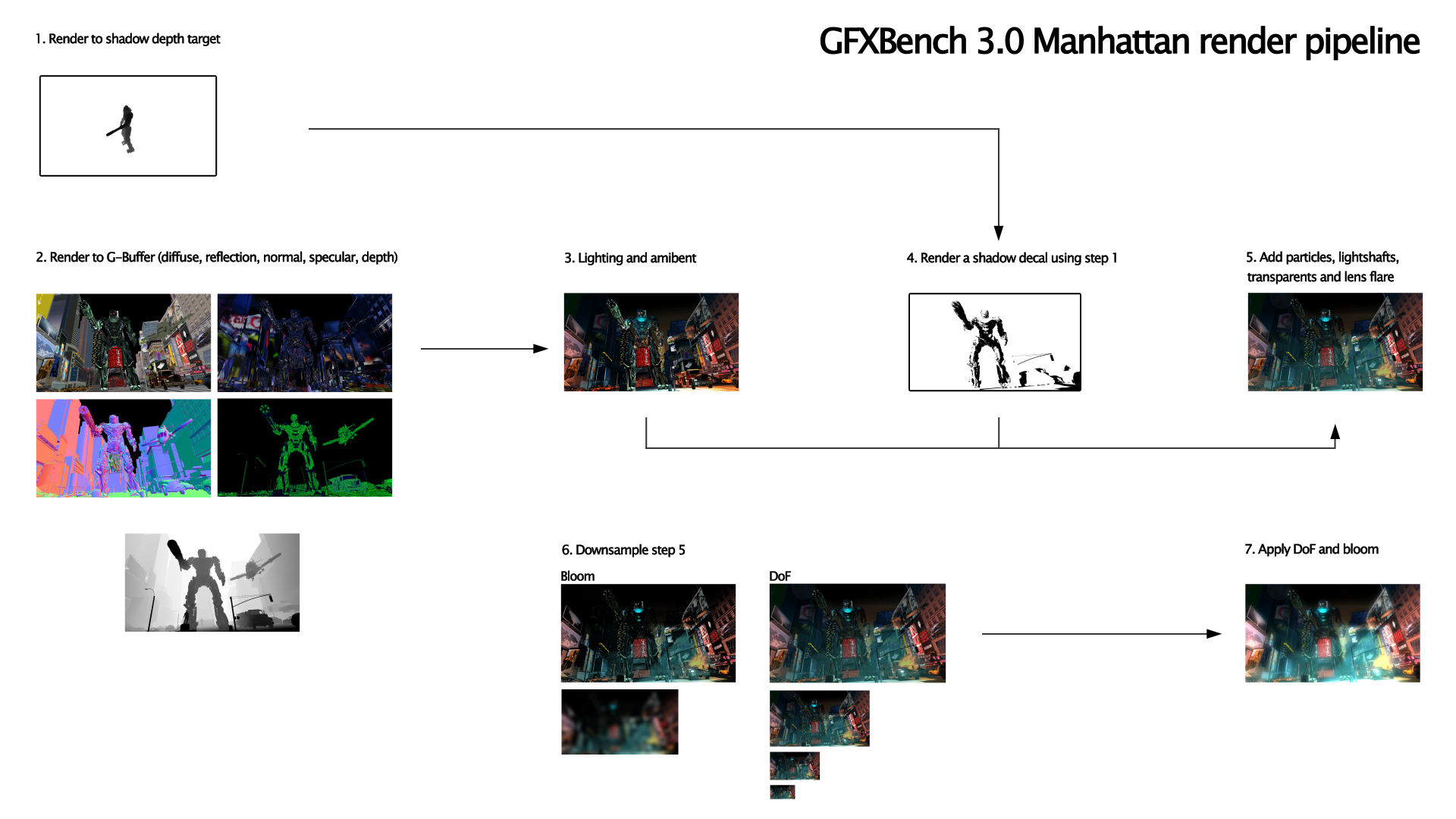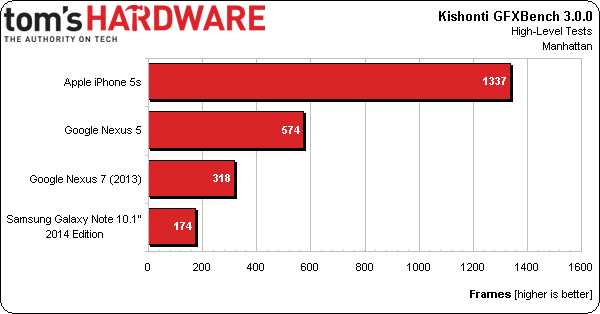GFXBench 3.0: A Fresh Look At Mobile Benchmarking
Over the past few years, Kishonti has become a leading name in mobile GPU benchmarking. The newly-released GFXBench 3.0 is comprised of nearly all new tests, including battery, render quality, and the first serious OpenGL ES 3.0 performance metric.
High-Level Test Results: Manhattan
Manhattan is a complex OpenGL ES 3.0-based test that takes place in a city at night. Its graphics pipeline is based on deferred shading. The geometry pass employs multiple render targets (MRTS). Diffuse and specular lighting is calculated for more than 60 lights. And the test also features cube map reflection and emission, triplanar mapping, and instanced mesh rendering. There's even a cool Theora-based video playback system that leverages asynchronous texture streaming.
As you might have guessed, of GFXBench's components, this one is the most modern.
The Manhattan test uses a combination of traditional forward and more modern deferred rendering processes in separate passes, along with bloom and depth of field added in the post process pass. The rendering order is as follows:
It’s important to note that only some of our devices can run Manhattan due to its OpenGL ES 3.0 requirement, which means at least iOS 7 and Android 4.3.
On-Screen
Let’s see how our devices handle Manhattan at their respective native screen resolutions.
Apple's iPhone 5s easily walks away with the crown, turning in more than double the rendered frames as Google's Nexus 5. Clearly, its native sub-720p resolution is a huge advantage.
Of the Android-based devices, the Nexus 5 finishes in the lead with a substantial advantage over the larger Nexus 7. That's unsurprising, considering its Adreno 330 GPU tends to finish at the top of the charts. The 2013 Google Nexus 7 puts in a decent showing with a slower Adreno 320 implementation and a 1920x1200 native resolution. Samsung's Galaxy Note 10.1 2014 is the real disappointment, as its ARM Mali-T628MP6 GPU falls to last place. A native QHD resolution of 2560x1600 does the tablet no favors.
Get Tom's Hardware's best news and in-depth reviews, straight to your inbox.
Off-Screen
At a fixed resolution of 1920x1080 rendered off-screen, we get a better sense of each SoC's performance, separate of the device's display.
The order changes slightly, but Apple's iPhone still enjoys a substantial lead. The Nexus 5 takes second place once again as well, though it renders fewer frames than the previous test. That's strange since its target resolution is the same. Perhaps there is some overhead associated with rendering off-screen. Samsung's Galaxy Note 10.1” 2014 Edition and Google's Nexus 7 swap places, with less than 10% separating them. Unfortunately, their performance is quite modest.
Current page: High-Level Test Results: Manhattan
Prev Page Going Beyond Performance Testing Next Page High-Level Test Results: T-Rex-
panzerknacker Its cool u guys put so much effort into this but tbh most of the benchmark results seem to be completely random. Phones with faster SoC's performing slower and vice versa. I think there is no point at all benching a phone because 1. The benchmarking software is a POS and unreliable and 2. The phone OS's and apps are all complete POSs and act completely random in all kinda situations. I'd say just buy the phone with a fast SoC that looks the best to u and when it starts acting like a POS (which they all start doing in the end) buy a new one.Reply -
umadbro What kind of bs is this? Force 720p on all devices and you'll see what happens to your precious 5s. Even my Zl murdered it.Reply -
jamsbong The only relevant benchmarks are the first two because they are full-fletch 3D graphics, which is won by the most portable device; The iPhone. The rest of the benchies are just primitive 2D graphics which is irrelevant. Android devices won all those in flying colours.Reply -
rolli59 Well I have a smart phone but that is so I can receive business emails on the go, I have a tablet because it is great for watching movies on the go. Do I want to find out if there are any faster devices to do those things, not really while what I got is sufficient. I leave all the heavy tasks to the computers.Reply -
Durandul ReplyThe only relevant benchmarks are the first two because they are full-fletch 3D graphics, which is won by the most portable device; The iPhone. The rest of the benchies are just primitive 2D graphics which is irrelevant. Android devices won all those in flying colours.
If those are the only two benchmarks relevant to you, then I wonder why you are using a phone and not a 3DS or something. But seriously, most of the other devices have more than a million more pixels then the iPhone, so this benchmark is not so telling. It was mentioned before, but it would be nice to test at a given resolution, although as suppose applications don't give you an option on the phone. -
umadbro Reply
It does give the option to force some specific resolution. Don't know why this "review" didn't do it. That's what I've been trying to say from the start.The only relevant benchmarks are the first two because they are full-fletch 3D graphics, which is won by the most portable device; The iPhone. The rest of the benchies are just primitive 2D graphics which is irrelevant. Android devices won all those in flying colours.
If those are the only two benchmarks relevant to you, then I wonder why you are using a phone and not a 3DS or something. But seriously, most of the other devices have more than a million more pixels then the iPhone, so this benchmark is not so telling. It was mentioned before, but it would be nice to test at a given resolution, although as suppose applications don't give you an option on the phone. -
umadbro Reply
It does give the option to force some specific resolution. Don't know why this "review" didn't do it. That's what I've been trying to say from the start.The only relevant benchmarks are the first two because they are full-fletch 3D graphics, which is won by the most portable device; The iPhone. The rest of the benchies are just primitive 2D graphics which is irrelevant. Android devices won all those in flying colours.
If those are the only two benchmarks relevant to you, then I wonder why you are using a phone and not a 3DS or something. But seriously, most of the other devices have more than a million more pixels then the iPhone, so this benchmark is not so telling. It was mentioned before, but it would be nice to test at a given resolution, although as suppose applications don't give you an option on the phone.



